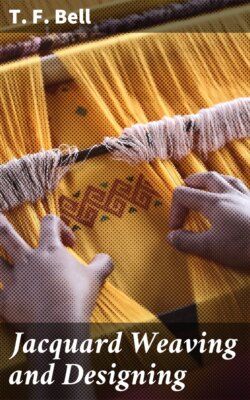Jacquard Weaving and Designing

Реклама. ООО «ЛитРес», ИНН: 7719571260.
Оглавление
T. F. Bell. Jacquard Weaving and Designing
Jacquard Weaving and Designing
Table of Contents
CHAPTER I. INTRODUCTION
READING OR LASHING THE PATTERN
CROSS’S COUNTERPOISE HARNESS
THE COMB DRAW LOOM
THE BARREL OR CYLINDER LOOM
FRENCH DRAW LOOM
CHAPTER II. JACQUARD MACHINES
DOUBLE-ACTING JACQUARD WITH TWO CYLINDERS
JACQUARD STOP MOTION
CHAPTER III. FULL-HARNESS MOUNTINGS
LINGOES OR LEADS
HARNESS TWINE
SETTING THE JACQUARD
HECKS OR GUIDE REEDS
PREPARING THE NECK OF THE HARNESS
CUMBER BOARDS AND HARNESS REEDS
SLABSTOCKS AND LEVELLING FRAMES
LEVELLING THE SLABSTOCK OR FRAME
TYING UP THE HARNESS
VARNISHING A HARNESS
TO ARRANGE THE TIE OF A HARNESS
TO MARK OUT A CUMBER BOARD
TO VARY THE SET OF THE HARNESS
CHAPTER IV. DESIGNING AND DRAUGHTING
LETTERS, MOTTOES, ETC
CHAPTER V. CARD-CUTTING AND LACING
WIRING CARDS
CHAPTER VI. SPECIAL JACQUARDS AND HARNESSES
CROSS-BORDER JACQUARDS
OPEN-SHED JACQUARDS
THE VERDÔL JACQUARD
HALF HARNESS AND MUSLIN HARNESSES
SPLIT HARNESS
PRESSURE HARNESS
TWILLING JACQUARDS
CHAPTER VII. GAUZE
HAND-LOOM GAUZE HARNESS
GAUZE HARNESS
THE GAUZE REED
CHAPTER VIII. DOUBLE CLOTH
DOUBLE CLOTH AND QUILTING HARNESSES
CHAPTER IX. TAPESTRY AND PILE WORK
CHAPTER X. CARPETS
CHAPTER XI. LAPPETS AND SWIVELS
CONCLUSION
INDEX
Отрывок из книги
T. F. Bell
Published by Good Press, 2019
.....
Fig. 12
Figs. 12a and 12b give detailed views of the hooks, etc., for drawing the harness: the letters in both refer to the same parts as are marked with similar letters in Fig. 12. The simples B are tied to loops on the hooks under the hole board C. In Fig. 12b it will be clearly seen how the needles in four rows act upon the hooks. The griffe consists of four round iron rods or wires set in the frame E, Fig. 12a, which can be drawn down by the treadle G, connected with the levers F by the cords 3 and 4. One of the levers has its fulcrum at one side and the other has it at the opposite side, and the points of the levers are tied to the griffe frame by the cords 1 and 2. The griffe, when sunk, is brought back to its place again by weights hanging on cords running over pulleys. It may be seen that the hooks hang in front of the rods or bars of the griffe; therefore, those hooks will be pushed on the griffe whose needles come against the solid portions of the cards, thus acting similarly to Bouchon’s machine. The hand bar for pressing the cards against the needles is shown at F. The needles can pass through the slot in it, and, when a card is pressed against the needles, the bar can be fastened with hooks for the purpose, so that the operator is free to depress the treadle. There are no springs on the needles, but a clap board comes behind them, which is pressed in by means of a cord passing over each end of it and fastened to a spiral spring. There are ten leaves of heddles in front of the harness. They are plain clasped heddles, and apparently act as five, the front five being raised by the top levers connected with the treadles, as shown in Fig. 11, and the back five are held up by a set of levers at each side, with weights on the ends of them, similarly to those now used for hand-loom damasks, and tied to the treadles below, so that sinking a treadle would cause one of the back leaves to sink and one of the front ones to rise. Only the harness mechanism of Falcon’s loom is given in Fig. 12, the front portion being similar to that of Bouchon, or to any hand loom.
.....